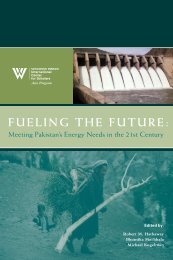Environmental Change and Security Project Report - Woodrow ...
Environmental Change and Security Project Report - Woodrow ...
Environmental Change and Security Project Report - Woodrow ...
You also want an ePaper? Increase the reach of your titles
YUMPU automatically turns print PDFs into web optimized ePapers that Google loves.
New models <strong>and</strong> technology address PHE<br />
linkages. Technological advances have enabled<br />
farmers to grow more food on less l<strong>and</strong>, cities to<br />
clean wastewater, <strong>and</strong> nations to protect areas of<br />
significant biodiversity. In India, for example,<br />
communities have used new technologies <strong>and</strong><br />
community mobilization to convert openaccess<br />
natural resources into community-controlled<br />
resources, thereby increasing the residents’<br />
incomes from forest products <strong>and</strong> protecting<br />
the area’s biodiversity (McNeely &<br />
Scherr, 2003, pages 46-47, 234). In addition,<br />
research-based programs <strong>and</strong> policies have<br />
enhanced environmental protection <strong>and</strong><br />
improved human well-being. Examples include<br />
Zimbabwe’s experience decentralizing wildlife<br />
user rights in the CAMPFIRE program, which<br />
was adopted in other Southern African countries,<br />
<strong>and</strong> the National Biodiversity Institute<br />
(INBio) of Costa Rica’s bioprospecting initiative,<br />
which was adapted by projects in Mexico,<br />
Indonesia, <strong>and</strong> the Philippines (World<br />
Resources Institute, 1997).<br />
Why have we not done more?<br />
Examining, designing, implementing, <strong>and</strong><br />
funding integrated work is a continuing<br />
challenge. A common stumbling block for<br />
researchers, program managers, local communities,<br />
<strong>and</strong> donors is how to “do integration.”<br />
PHE scholars <strong>and</strong> practitioners have not settled<br />
on a unifying methodology. Program documentation<br />
tends to target the funding agency <strong>and</strong><br />
should be disseminated broadly so that other<br />
program managers can determine when to apply<br />
an integrated approach. Similarly, decisionmakers<br />
grapple with how to apply integrated<br />
policies across sectors, budgets, <strong>and</strong> regulations.<br />
And donors remain largely wedded to traditional<br />
sectoral funding approaches, only occasionally<br />
dabbling in cross-sectoral experiments.<br />
The complexity of these linkages clouds the<br />
appropriate intervention points. Intuitively,<br />
linking population, health, <strong>and</strong> environment<br />
issues makes sense. This link is less clear, however,<br />
when other variables, such as technology,<br />
culture, economics, or politics, come into play.<br />
What kind of interventions will have the greatest<br />
impact? If we want to preserve old growth<br />
forests, should we fight corruption that awards<br />
favorable concessions to rapacious logging companies,<br />
or should we prevent migrant workers<br />
from moving in? These interventions are difficult<br />
to evaluate, partly due to poor-quality data<br />
on the factors driving change.<br />
Collaboration is complicated by major<br />
differences in paradigms, assumptions, <strong>and</strong><br />
definitions. Reconciling different (<strong>and</strong> sometimes<br />
contradictory) conceptual approaches is<br />
complicated by divergent methodologies <strong>and</strong><br />
the conflicting interests of individuals, communities,<br />
organizations, <strong>and</strong> governments.<br />
Business as usual often stymies collaboration.<br />
Some organizations are reluctant to add a<br />
program in another sector, like a conservation<br />
organization providing family planning services,<br />
even if it would maximize their impact. They do<br />
not have the resources, expertise, or staff capacity,<br />
<strong>and</strong> they feel that such efforts would divert<br />
them from their stated mission. Similarly,<br />
donors fund projects according to specific program<br />
areas, <strong>and</strong> when funding is tight, they fall<br />
back on more established programs. At the<br />
community level, integrated programs may be<br />
constrained by cultural <strong>and</strong> religious norms,<br />
especially when addressing sensitive issues like<br />
the role of women in natural resource management<br />
or voluntary modern family planning<br />
methods. Traditional practices, cultural differences,<br />
or powerful interests may block integrated<br />
efforts to change the status quo.<br />
The exclusion of “influentials” impedes<br />
implementation. Influentials (e.g., journalists,<br />
important community members, <strong>and</strong> political,<br />
civic, <strong>and</strong> religious leaders) can shape policy<br />
<strong>and</strong> influence attitudes <strong>and</strong> behaviors. When<br />
influentials are excluded from a research project<br />
or program, they may not support its recommendations.<br />
Journalists, for example, need simple<br />
ways to explain the demographic <strong>and</strong> health<br />
dimensions of environmental stories, a news<br />
“peg” that can sell the story to their editors, <strong>and</strong><br />
access to information <strong>and</strong> experts. If the media<br />
are included in projects <strong>and</strong> given opportunities<br />
to report, they could help bring PHE issues to<br />
A common stumbling<br />
block for<br />
researchers, program<br />
managers,<br />
local communities,<br />
<strong>and</strong> donors is how<br />
to “do integration.”<br />
31<br />
COMMENTARY • THE NEXT STEPS FOR ENVIRONMENT, POPULATION, AND SECURITY

















